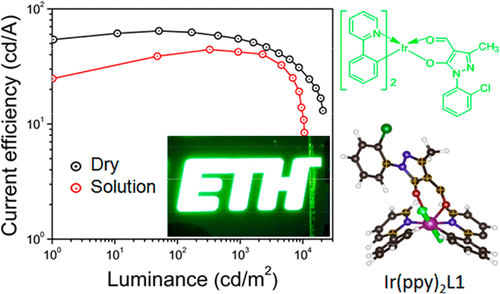[Inorg. Chem] Design and Synthesis of Heteroleptic Iridium(III) Phosphors for Efficient Organic Light-Emitting Devices
We report high-efficiency phosphorescent OLEDs based on new Heteroleptic Iridium(III) compounds.

The phosphorescent emitters are essential to realize energy-efficient display and lighting panels. The solution processability is of particular interest for large-scale and low-cost production. Here, we present a series of the heteroleptic iridium (Ir) complexes, Ir(ppy)2L1, Ir(ppy)2L2, and Ir(ppy)2L3, using the new ancillary ligands, including 1-(2-chlorophenyl)-5-hydroxy-3-methyl-1H-pyrazole-4-carbaldehyde (L1), 5-hydroxy-3-methyl-1-(p-tolyl)-1H-pyrazole-4-carbaldehyde (L2), and 5-hydroxy-3-methyl-1-phenyl-1H-pyrazole-4-carbaldehyde (L3). Their photophysical and electrochemical properties were systematically characterized, followed by comparing with those predicted by density functional theory simulations using hybrid functionals. Among the three phosphors synthesized, Ir(ppy)2L1 exhibits the highest photoluminescence quantum yield (ΦPL = 89%), with an exciton lifetime of 0.34 μs. By using 4,4′-bis(carbazole-9-yl)biphenyl as the host material, we demonstrate high current efficiencies of 64 and 40 cd A–1 at 100 cd m–2 in its vacuum-evaporated and solution-processed organic light-emitting devices, respectively, revealing the promise for large-area light sources.
external pageInorg. Chem DOI: 10.1021/acs.inorgchem.7b02872call_made
